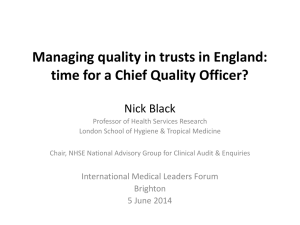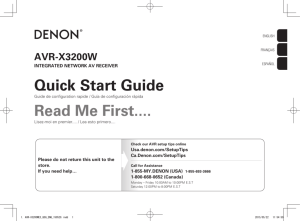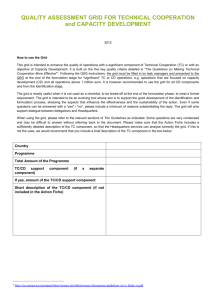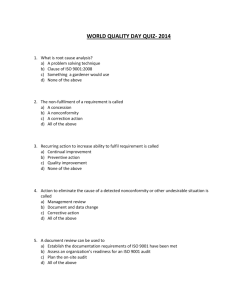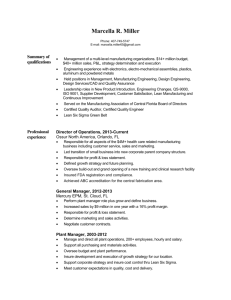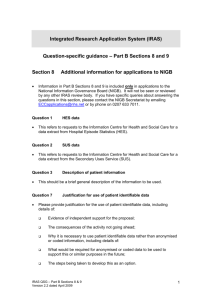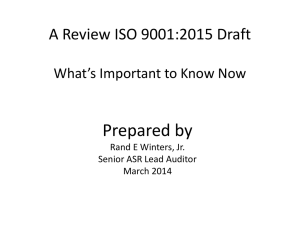“Risk Based Thinking” Model for ISO 9001:2015
advertisement
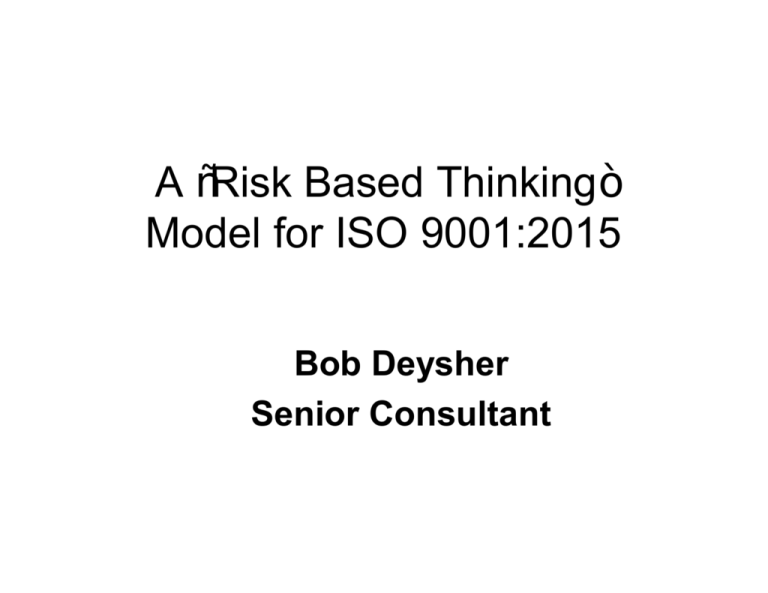
A “Risk Based Thinking” Model for ISO 9001:2015 Bob Deysher Senior Consultant ©2014 QSG, Inc. Agenda • Why implement Risk Based Thinking? – What does ISO 9001:2015 require? • • • • What is Risk Based Thinking? What is Risk? What is a simple Risk Tool? How does it integrate into the Process Approach? • How do you make Risk Based Thinking a Continual Process Improvement activity? January 15, 2015 ©2014 QSG, Inc. 2 ISO 9001:2015 Risk & Opportunities 4.4 Quality management system and its processes The organization shall establish, implement, maintain and continually improve a quality management system, including the processes needed and their interactions, in accordance with the requirements of this International Standard. The organization shall determine the processes needed for the quality management system and their application throughout the organization and shall determine: f) the risks and opportunities in accordance with the requirements of 6.1, and plan and implement the appropriate actions to address them; January 15, 2015 ©2014 QSG, Inc. 3 ISO 9001:2015 Risk & Opportunities 6 Planning for the quality management system 6.1 Actions to address risks and opportunities 6.1.1 When planning for the quality management system, the organization shall consider the issues referred to in 4.1 and the requirements referred to in 4.2 and determine the risks and opportunities that need to be addressed to: a) give assurance that the quality management system can achieve its intended result(s); b) prevent, or reduce, undesired effects; c) achieve continual improvement. January 15, 2015 ©2014 QSG, Inc. 4 ISO 9001:2015 Risk & Opportunities 6.1.2 The organization shall plan: a) actions to address these risks and opportunities; b) how to: 1) integrate and implement the actions into its quality management system processes (see 4.4); 2) evaluate the effectiveness of these actions. Actions taken to address risks and opportunities shall be proportionate to the potential impact on the conformity of products and services. January 15, 2015 ©2014 QSG, Inc. 5 The Main Objectives of International Standards • To provide confidence in the organization’s ability to consistently provide customers with conforming goods and services • To enhance customer satisfaction The concept of “risk” in the context of the international standards relates to the uncertainty in achieving these objectives January 15, 2015 ©2014 QSG, Inc. 6 What is Risk Based Thinking? January 15, 2015 ©2014 QSG, Inc. 7 What is “Risk-Based Thinking”? • Risk-based thinking is something we all do automatically and often sub-consciously • The concept of risk has always been implicit in ISO 9001 – the 2015 revision makes it more explicit and builds it into the whole management system • Risk-based thinking is already part of the process approach • Risk-based thinking makes preventive action part of the routine • Risk is often thought of only in the negative sense. Risk-based thinking can also help to identify opportunities. This can be considered to be the positive side of risk January 15, 2015 ©2014 QSG, Inc. 8 Why Should I adopt “Risk-Based Thinking”? • To improve customer confidence and satisfaction • To assure consistency of quality of goods and services • To establish a proactive culture of prevention and improvement • Successful companies intuitively take a riskbased approach January 15, 2015 ©2014 QSG, Inc. 9 What Should I Do? Identify what the risks and opportunities are in your organization – it depends on context –ISO 9001:2015 will not automatically require you to carry out a full, formal risk assessment, or to maintain a “risk register” –ISO 31000 (“Risk management — Principles and guidelines”) will be a useful reference (but not mandated) January 15, 2015 ©2014 QSG, Inc. 10 What Should I Do? (continued) • Analyse and prioritize the risks and opportunities in your organization – what is acceptable? – what is unacceptable? • Plan actions to address the risks – how can I avoid or eliminate the risk? – how can I mitigate the risk? • Implement the plan – take action • Check the effectiveness of the actions – does it work? • Learn from experience – continual improvement January 15, 2015 ©2014 QSG, Inc. 11 Key Points to Remember Risk Based Thinking = Preventative Action Risk Based Thinking is everybody’s business! – Risk Based Thinking is not just the responsibility of management – Risk Based Thinking must become an integral part of the organizational culture January 15, 2015 ©2014 QSG, Inc. 12 What is Risk? Risk is the possibility of events or activities impeding the achievement of an organization’s strategic and operational objectives. January 15, 2015 ©2014 QSG, Inc. 13 Risk – A Simple Definition The volatility of potential outcomes. or How surprised do you really want to be?? January 15, 2015 ©2014 QSG, Inc. 14 Food for Thought • Why is Risk like Swiss Cheese? Author needs to acknowledge that this idea was shown at the NQA Meeting, Boston Session, August 2014 January 15, 2015 ©2014 QSG, Inc. 15 Risk Definitions Risk can be defined by two (2) parameters – Severity • This is the Seriousness of the harm – Probability • This is the Probability that the harm will occur January 15, 2015 ©2014 QSG, Inc. 16 Risk Assessment - Quantitative January 15, 2015 ©2014 QSG, Inc. 17 Risk Acceptable Regions Generally Un-Acceptable As Low As “Reasonably” Practical Generally Acceptable January 15, 2015 ©2014 QSG, Inc. 18 Risk Assessment - Qualitative January 15, 2015 ©2014 QSG, Inc. 19 Risk Registers January 15, 2015 ©2014 QSG, Inc. 20 The Importance of a Risk Register • The risk register or risk log becomes essential as it records identified risks, their severity, and the actions steps to be taken. • It can be a simple document, spreadsheet, or a database system, but the most effective format is a table. • A table presents a great deal of information in just a few pages. January 15, 2015 ©2014 QSG, Inc. 21 Components of a Risk Register There is no standard list of components that should be included in the risk register. Some of the most widely used components are: • Dates: As the register is a living document, it is important to record the date that risks are identified or modified. Optional dates to include are the target and completion dates. • Description of the Risk: A phrase that describes the risk. • Risk Type (business, project, stage): Classification of the risk: Business risks relate to delivery of achieved benefit;, project risks relate to the management of the project such as timeframes and resources, and stage risks are risks associated with a specific stage of the plan. • Likelihood of Occurrence: Provides an assessment on how likely it is that this risk will occur. Examples are: L-Low >30%)(, M-Medium (3170%), H-High (>70%). • Severity of Effect: Provides an assessment of the impact that the occurrence of this risk would have on the project. January 15, 2015 ©2014 QSG, Inc. 22 Components of a Risk Register There is no standard list of components that should be included in the risk register. Some of the most widely used components are: • • • • Countermeasures: Actions to be taken to prevent, reduce, or transfer the risk. This may include production of contingency plans. Owner: The individual responsible for ensuring that risks are appropriately engaged with countermeasures undertaken. Status: Indicates whether this is a current risk or if risk can no longer arise and impact the project. Example classifications are: C-current or E-ended. Other columns such as quantitative value can also be added if appropriate. January 15, 2015 ©2014 QSG, Inc. 23 Risk Registers - Example January 15, 2015 ©2014 QSG, Inc. 24 Risk Registers - Example January 15, 2015 ©2014 QSG, Inc. 25 Integrating Risk Based Thinking with the Process Approach January 15, 2015 ©2014 QSG, Inc. 26 Purpose of the Process Approach The purpose of the process approach is to enhance an organization’s effectiveness and efficiency in achieving its defined objectives. This means enhancing customer satisfaction by meeting customer requirements. January 15, 2015 ©2014 QSG, Inc. 27 Is This a Process Model in Your Organization? January 15, 2015 ©2014 QSG, Inc. 28 or does your Process Approach look like this? January 15, 2015 ©2014 QSG, Inc. 29 or does your Process Approach look like this? January 15, 2015 ©2014 QSG, Inc. 30 Materials Measures Manpower (With What?) (Trend Charts) (Metrics) (Training) (Skills) Process Inputs Suppliers (By Whom) (Major Elements & Boundaries) Start End Process Owners: Outputs Customers (for Whom?) Risks (What Can Go Wrong?) Methods Machine Environment (How?) (With What?) (Area Conditions?) January 15, 2015 ©2014 QSG, Inc. 31 Proposed Risk Model January 15, 2015 ©2014 QSG, Inc. 32 Proposed Risk Model - Populated New Risk Value Post Action Plans January 15, 2015 ©2014 QSG, Inc. 33 Food for Thought • Why is Risk like Swiss Cheese? Author needs to acknowledge that this idea was shown at the NQA Meeting, Boston Session, August 2014 January 15, 2015 ©2014 QSG, Inc. 34 Addressing Risk January 15, 2015 ©2014 QSG, Inc. 35 Integrating Risk Based Thinking with the Process Approach and PDCA January 15, 2015 ©2014 QSG, Inc. 36 Plan-Do-Check-Act The Plan-Do-Check-Act (PDCA) methodology can be a useful tool to define, implement and control corrective actions and improvements. Extensive literature exists about the PDCA cycle in numerous languages. January 15, 2015 Act Plan •How to improve next time? •What to do? •How to do it? Check Do • Did things happen according to plan? •Do what was planned ©2014 QSG, Inc. 37 ActIncorporate improvements as necessary January 15, 2015 INPUTS Plan the process (Extent of planning depends on RISK) Do – Carry out the process Check – monitor/measure process performance ©2014 QSG, Inc. OUTPUTS Interaction with other process Interaction with other process Process + Risk + PDCA Model 38 Management Review Input Top management shall review the organization's quality management system, at planned intervals, to ensure its continuing suitability, adequacy, and effectiveness. The management review shall be planned and carried out taking into consideration: a) the status of actions from previous management reviews; b) changes in external and internal issues that are relevant to the quality management system including its strategic direction; c) information on the quality performance, including trends and indicators for: 1) nonconformities and corrective actions; 2) monitoring and measurement results; 3) audit results; 4) customer satisfaction; 5) issues concerning external providers and other relevant interested parties; 6) adequacy of resources required for maintaining an effective quality management system; 7) process performance and conformity of products and services; d) the effectiveness of actions taken to address risks and opportunities (see clause 6.1); e) new potential opportunities for continual improvement. January 15, 2015 ©2014 QSG, Inc. 39 Conclusions • Risk Based Thinking is an element in the Process Approach • Risk Based Thinking is an input to Management Review • Risk Based Thinking is an element in the continual improvement process that is focused on prevention. • Risk Based Thinking has be be demonstrated during audits; a risk register is documented information that validates an organization has done Risk Based Thinking. January 15, 2015 ©2014 QSG, Inc. 40 Questions??? January 15, 2015 ©2014 QSG, Inc. 41 References • ISO 9000 Introduction and Support Package: Guidance on the Concept and Use of the Process Approach for management systems, ISO/TC 176/SC 2/N 544R3 • ISO 9001:2008 • ISO 9001:2015 • “Implementing the Process Approach”, Core Business Solutions, Inc., March 31, 2008. • The Process Approach: Adding Business Value and Minimizing Risks; David Muil, Intertek. • “The PDCA Continuous Improvement Cycle; Module 6.4”, Jeremy Weinstein and Steve Vasovski , 2004 January 15, 2015 ©2014 QSG, Inc. 42
